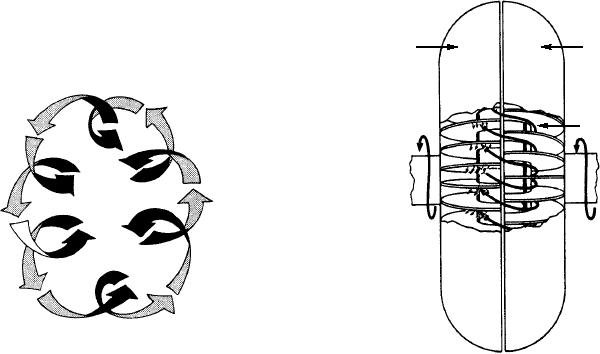
turbine, and back to the pump. The drop would follow a
With fluid couplings, shock loads can never be
path that looks something like a string wound around a
transmitted into the engine. Sudden gear-breaking
doughnut through the hole (fig. 2-50). This path of oil
jerks are impossible. If a vehicle is overloaded, the
is called a vortex and is the path of the stream of oil that
fluid coupling slips and never allows the engine to
drives the turbine. There are as many vortex streams in
become overloaded. Thus, harmful low-speed lugging
a fluid coupling as there are vanes.
o f t h e e n g i n e i s i m p o s s i b l e . Vi b r a t i o n s a n d
irregularities of the engine can be harmful to the rest of
As the turbine begins to turn, the difference in
the vehicle's power train, but with fluid couplings, it is
speed between the pump and the turbine decreases. As
impossible for these engine irregularities to be
the speed difference decreases, the coils of the vortex
transmitted to the power train.
become closer together. A LOW VORTEX exists when
Since a fluid coupling is nothing more than a sort
the pump and turbine are traveling at nearly the same
of connecting link, it can deliver only the torque or
speed. A HIGH VORTEX exists when the pump and
"twist" delivered to it; it cannot increase torque or
turbine speeds differ greatly.
power. To get this added feature requires the use of a
The higher the vortex, the greater is the driving
torque converter.
power of the oil. When the vortex is high, the oil tends
to strike the fins on the turbine at nearly a right angle.
TORQUE CONVERTERS
The degree of vortex is continually changing and is
At first glance, torque converters appear very
determined by the difference in speed between the
similar to fluid couplings and, in fact, are similar in
members of the coupling.
several ways. Both have a driving member and a driven
A condition known as "zero vortex" or "fluid
member. Both transmit torque (or power) by passing
coupling stage" exists only when the two members of
oil from the vanes of the pump to the vanes of the
the fluid coupling are turning at exactly the same
turbine. However, the fluid coupling is essentially a
speed. When this happens the fluid coupling actually
special form of clutch that transmits torque at
has no driving power. The pump, turbine, and the fluid
maximum efficiency when both members are turning
within the coupling are all turning as one unit in a
at close to the same speed. When the pump turns
rotary motion.
appreciably faster than the turbine, the efficiency
coupling of torque into the turbine is lowered.
The fluid coupling stage seldom exists because the
turbine usually lags a little behind the pump when there
Figure 2-51 shows a fluid coupling with the
is a load on the vehicle. The fluid coupling stage exists
driving member (pump) turning much faster than the
momentarily when the vehicle begins to coast or
reduce speed. As soon as the engine slows down, the
momentum of the vehicle causes the turbine to throw a
vortex of oil at the pump, thus permitting the engine to
DRIVEN
DRIVING
help reduce the speed of the vehicle by creating a drag.
MEMBER
MEMBER
FLOW OF
OIL
VORTEX FLOW IN A FLUID
ASf02051
ASf02050
Figure 2-51.--Fluid coupling oil flow "bounce back" effect.
Figure 2-50.--Schematic of vortex flow in a liquid.
2-41

